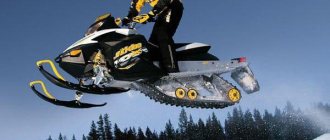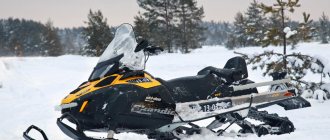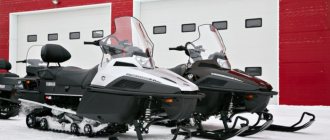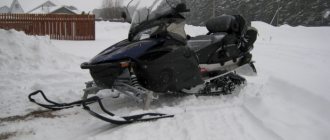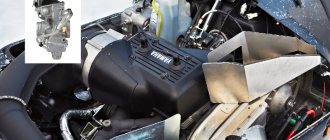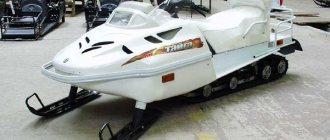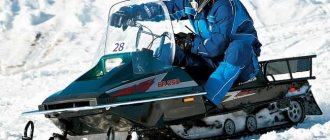Yamaha Viking 540 3 is a high-quality snowmobile from a well-known manufacturer from Japan. This car has a classic layout, has a strict and simple design, as well as a high windshield. The model in question comes mainly in a black version, which is considered the most practical. Before us is the fourth model of the Viking family from the famous Japanese brand, known for the production of automobile and motorcycle equipment. The Viking 540 III model turned out to be no less popular than its predecessor, which had unprecedented characteristics for its time, and was significantly different from its competitors in terms of handling, maneuverability, reliability and cross-country ability. That is why the Viking 540 III model deserves special attention, since it has received significant improvements and is more modern and relevant than its predecessor of the same name.
Among the main features of the machine, we note the impressive technical characteristics, the high level of which is not inferior to most famous analogues. In general, this type of transport has absorbed all the best that experienced Yamaha specialists have. First, let's pay attention to the wide track with excellent cross-country ability. In addition, thanks to the special shape of the caterpillar, it was possible to increase directional stability, and thereby reduce the risk of capsizing. Moreover, the durable caterpillar significantly increases the load capacity - by the way, according to this indicator, snowmobiles of the Viking family have always been considered the best. The car overcomes obstacles, rocks and deep snowdrifts without any problems. At the same time, you don’t even have to slow down, since the caterpillar is made of durable components that are resistant to deformation and various damages. This factor is extremely important at low temperatures, including in the northern regions of Russia - in such conditions problems with reliability most often arise. But the Viking 540 III is adapted to the most severe temperature loads.
Secondly, let’s pay attention to several pleasant features that benefit cross-country ability and stability. This is a multifunctional gearbox with forward and reverse positions that can be used under heavy loads - for example, for transporting and towing large and heavy loads. Reliable and uninterrupted starting is ensured by a powerful electric starter, thanks to which the engine starts almost instantly, and for this it does not need to be warmed up. But as a last resort, you can always use a manual starter, which means that the engine will start in any case, and in any weather. All of the listed components are the prerogative of the basic configuration.
Video
Returning to the chassis, we will pay special attention to the tracked chassis. There is one single caterpillar installed at the rear, which is distinguished by its increased dimensions. Its length is 4 meters, while the length of the snowmobile itself reaches three meters. At the same time, the track width is 500 mm, which is an important factor that ensures high-quality maneuverability in deep snow. Among other parameters that benefit off-road qualities, it is worth noting the ski base, which is about 1000 mm.
Of the other positive qualities of the Yamaha Viking 540 III snowmobile discussed above, we separately note the load capacity. In this parameter, the model under consideration is not inferior to most analogues, and in some ways surpasses them. According to official data, this snowmobile is capable of transporting more than 300 kg of cargo, while the permissible speed can reach 60 km/h. Practice shows that with the help of a towbar you can attach any load whose mass exceeds the weight of the snowmobile itself. Especially for such high loads, the gearbox has a reduction gear. Thus, we can talk about the high traction capabilities of the Yamaha Viking 540 III snowmobile without fear of reliability problems. The machine is suitable for absolutely any task and will satisfy the practical user - fisherman, hunter, or lovers of recreation and active adventures with their family.
Caterpillar
The second most important element in a snowmobile is, of course, the track. The technical characteristics of Yamaha motorcycles are very often determined by their wheel travel, and for snowmobiles, accordingly, by their track. In the case of this model, the length of the track is almost four meters, while the length of the snowmobile itself is approximately three meters. It is also worth noting the impressive width of the track, which is just over half a meter - this width provides excellent load capacity, as well as excellent cross-country ability on any snow. Don’t forget about the base of the skis, since tracks and skis are considered as a set - just like cars and motorcycles have drive and driven wheels. The size of the ski base is almost a whole meter, which also has a positive impact on the performance of this model. The Yamaha Viking 540 III snowmobile, which has received extremely positive reviews, is completely worth the money you spend on it.
Specifications
- Engine – petrol, volume 535 cc. cm.
- Power – 46 horsepower
- Cylinders, pcs. – 2
- Cooling system – air
- Cylinder diameter – 73 mm
- Piston stroke – 64 mm
- Intake system/fuel system - reed valves/Mikuni carburetor
- Ignition system - CDI
- Exhaust system - one resonator
- Transmission – YVXC, variator with reduction and overdrive gears, as well as reverse
- Lubrication – separate type, automatic
- Transfers to the checkpoint, pcs. – 3 (including reverse)
- Frame – steel
- Front suspension/front shock absorbers – telescopic/hydraulic
- Ski material – steel
- Front suspension travel – 150 mm
- Rear suspension – Pro Action Plus, 290mm travel
- Dry weight – 290 kg
- Snowmobile dimensions, mm: Length/Width/Height – 3120/1130/1350
- Caterpillar dimensions, mm: Length – 3960, Width – 500 mm
- Fuel tank/oil tank (volume) – 31/2.5 liters
Basic options: electric starter, reverse speed, heated steering wheel, grips and throttle lever; high windshield, rear-view mirrors, tow bar, halogen headlights, speedometer, odometer, tachometer, oil level and engine temperature indicators.
Load capacity
The last important technical characteristic of this snowmobile is its load capacity. As mentioned above, it literally surprises - with its own weight of less than 300 kilograms, it can easily carry more weight at an excellent speed of 60 kilometers per hour. Please note that you can also secure a load of even greater weight behind you - a reduction gear will help you drag it. The result is a virtually ideal snowmobile, which has deservedly earned its worldwide fame and has repeatedly confirmed that it is ideal for any tasks assigned to it.
Engine
The Yamaha Viking 540 III snowmobile is equipped with a time-tested engine, which is borrowed from its predecessor, but has significant improvements in terms of efficiency, environmental friendliness and higher power. This power plant impresses with its improvements and advanced characteristics, because it is considered one of the most powerful and energy efficient today - at least in its price category. Thus, the working volume of the power plant is 0.5 liters, and the power is 46 horsepower. This power output is enough to avoid problems with cross-country ability. In addition, 46 forces allow you to move quite quickly on rolled snow, on straight and level roads. The engine is air cooled, which is considered the simplest compared to liquid cooling. The two-stroke, two-cylinder layout is compact and lightweight, which benefits a more rational organization of the engine compartment and also reduces the weight of the snowmobile. High technology is provided by the Mikuni B38 carburetor system, as well as an exhaust system with reed valves. There is an electric start as well as a manual starter. All of the listed components operate reliably and without interruption, and make it possible to achieve high environmental friendliness and low fuel consumption under high loads.
Yamaha Viking 540 Snowmobile Review
We'll start with the Yamaha 540 snowmobile, also known as the Viking, and also the VK540. The first snowmobile of this line came out in the early 80s. Of course, I wouldn’t want to start with the minuses, but any consumer first looks at the appearance. In our case, the appearance did not change much. Yamaha, have you decided to use AvtoVAZ’s marketing ploy? I’ll tell you, after all, this is not an effective move, because But still, a snowmobile is a status, and having bought it, you want to show it to your friends and comrades. And here people won’t even understand whether you bought it new or from the 80s. Taking into account the current exchange rate, the price for a Yamaha Viking 540 is 808,500 rubles, which is not small and is comparable to snowmobiles of other brands such as BRP, Polaris, Arctic Cat. And I still get the same snowmobile from 40 years ago, slightly updated - it’s a shame.
All? Thought the “pros” were over? But no, one cannot fail to note the real merits of the Yamaha 540 snowmobile. Before the crisis and price increases, it was one of the most popular snowmobiles, after the domestic Buran and Taiga. Why did this snowmobile resonate with those who bought it? First of all, the price, which was up to 300 thousand rubles, when the price of domestic snowmobiles ranged from 150 thousand rubles to 200 thousand rubles. But the main buyer of the snowmobile was either a hunter or a fisherman. Therefore, the design requirements were minimal. The people have a nickname for the Viking - “Iron”, for some reason, like Buran. The reliability of the Yamaha VK540 3 and 4 two-stroke snowmobile was excellent, but there were also many quality issues: pistons burned out, drive shafts on the caterpillars burst in half (some kind of disease), etc.
Previously, people bought a snowmobile because of the price, but now Yamaha itself is ruining its advantage. Yes, there are changes in technical specifications after decades, let's look at them.
Characteristics of the Yamaha VK540 snowmobile:
- The engine here is a 2-stroke with 535 cc and 46 hp. The motor is not bad, high-torque, unpretentious, air-cooled. But there have been cases that the Taiga has a 2-carburetor with 55 hp. loaded with a sleigh drove through fresh powder, and the VK540 did not have enough power and had to follow the Taiga 550.
- Fuel delivery is provided by a heated Mikuni carburetor - this is new to the VK540 V, so there is nothing to add.
- There is also already a separate engine lubrication system, about which there are only positive reviews.
- The front suspension is telescopic with Hydraulic shock absorbers, suspension travel is 150 mm. Just like the old system with many bushings that quickly develop play in the steering and fail. Because of this, the turning radius of the Yamaha VK540 is not at all humane, about 1.5 times greater than that of the Scandic VT 550.
- ProComfort rear suspension with raised rail ends and 278mm of suspension travel. The ride is good, but in fact, with two people, the suspension sinks so deeply that when moving along ravines, you can leave the rear mudguard on. Because it scrapes the ground.
- 50th track with 38 mm lug - Yamaha has finally increased the lug on its snowmobile, because... until 2012 it was 25 mm, and then became 32 mm with the introduction of the VK540 IV. The cross-country ability of the Viking 540 3 and 4 snowmobile therefore suffered, compared to the Scandic 550, which had a track with a 38mm height installed a long time ago.
- The new, comfortable, high seat of the VK 540-5 is a straight soft bench! Even Taiga makes the seats slightly different in height!!! Not to mention ATVs and snowmobiles, 90% of all utilitarian models. Because resting the driver's fifth point is not only convenient, but also safe on rough terrain. Previously there was a proper seat with a step. Apparently they decided to save money.
Personal experience.
Okay, they made the seat for the Viking 540-5 snowmobile, but why didn’t they raise the steering wheel? From personal experience, when moving through fields and forests, you regularly have to cross roads. And the snowier the Winter, the higher the parapets across the road. What do we do when we move? We stand on the steps and maneuver our bodies across the road. We're definitely not moving while sitting. What am I talking about... Yes! On Scandic, you hold the steering wheel fully upright with my height of 175 cm. And on the Viking you will have to overcome any obstacles on bent legs and in the shape of a question mark, where you need to drive while standing. And at the end of the day, even a 25-year-old guy will feel like an old man, with creaks in his lower back and back. These are personal memories.
In general, the Viking itself is not a bad snowmobile. An easy-to-maintain scrap that lives quietly in our area. Very repairable. But unfortunately, its dry weight of 290 kg and power of 46 horsepower also play a significant role in opposing it.
Reviews
- Ivan, Buryatia. I quickly got used to the car. The Yamaha Viking 540 III snowmobile is easy to operate. It is capable of towing up to 300 kg of cargo or more. Handling is excellent. The device is adapted to frosty conditions; fortunately, a powerful electric starter is specially provided for this, and if necessary, you can use a manual starter. Currently the mileage is 600 kilometers. During the run-in, funny incidents happened, candles were thrown. Now the snowmobile works great and is a pleasure to drive. The car is made of high-quality materials, but I was not impressed by the too simple design - strict and uncomplicated. In addition, the snowmobile is all black, and there is not a single bright element in it. Nothing unusual, no frills. Maybe I'm being too picky, but the fact is that this device is sometimes driven by my wife, who loves all sorts of bright things, like her Nissan Juke. It turns out that the only serious drawback is the design. The advantages are load capacity, controllability and cross-country ability.
- Valery, Kaliningrad. A good snowmobile for daily trips in deep and packed snow. The car impressed first of all for its smooth ride and sharp handling, but there are questions about cross-country ability. Based on its behavior on the road, it immediately becomes clear that the snowmobile is intended more for smooth and level roads, but if necessary, it can surprise with something even in a deep snowdrift. The car is not heavy at all thanks to the lightweight materials that are present in the body panels, as well as in the elements of the engine compartment. I was pleased with the low fuel consumption and support for 92 gasoline. Perhaps the following are the disadvantages - a stiff suspension, a low windshield, small instruments (you have to look closely at them, and they glare strongly in the sun), expensive maintenance and a complex design of the snowmobile. Repairing it yourself is not so bad.
- Mikhail, Komi. I didn't like the car. I thought about taking a Japanese one, since today supposedly there is no better technology to be found, but that was not the case. Problems arise with excessive consumption of fuel and oil. I didn’t like that there was no engine temperature sensor (I didn’t have one in the basic configuration). I also noticed that the snowmobile is awkward in deep snow and there is a high risk of capsizing. The design of the snowmobile is nothing at all. In terms of design, the Japanese are even worse than any Chinese. And at the same time the car costs a lot of money. For all its shortcomings. The engine is demanding on the quality of gasoline, and you need to buy only original components so that there are no problems with quality and reliability. During the run-in, when 80 kilometers had passed, the car immediately consumed 50 liters of gasoline... I do not recommend anyone to buy this miracle.
What is a snowmobile for?
As a rule, it is replaced by snowmobiles. These could be snowmobiles from Yamaha, Ermak, or Russian Mechanics. All such equipment for moving on snow will be the optimal transport for snowy areas, because it allows you to use the rain sheet for the fastest and most comfortable transportation.
Snowmobile
Of course, without this type of movement it is impossible to imagine communication in those areas where it is not possible to build roads.
Snowmobiles will become very relevant for those who love fast and well-controlled riding, as well as hunting in snowy areas.
Thus, this unit is really great for performing its functions and allows you to move quickly in the snow.
For more information about snowmobiles, watch the video:
Features of Yamaha snowmobiles
Yamaha snowmobiles come in four types:
- Utilitarian, for movement in difficult conditions;
- Tourist, for thrills;
- Sports, providing more active recreation;
- Mountain, for snow-capped peaks.
These vehicles have engines of approximately 40 horsepower, long and wide tracks, and can be equipped with trailers and luggage racks. Sports models can accelerate to 200 km/h .
They easily cope with obstacles.
VK540 II 1994-1998
For many people, the VK540 II has become the best partner for the toughest jobs. This model belongs to the Yamaha line of utilitarian equipment. Big and powerful, the VK540 II has everything you need to handle the toughest winter jobs. For many years, workers used it on the snowy trails of Alaska. It uses a Yamaha YXRC CVT with a wide belt, a range and reverse gear. The design of the VK540 II is made in the Ultra-Block style. Its 20-inch, 156-inch long track is optimal for driving in deep snow.
Plenty of luggage space
The VK540II knows what it takes to successfully transport heavy loads. It has a spacious cargo area in the rear, and there's ample luggage capacity under the saddle so you can haul even more stuff. The heavy duty hitch makes this sled a great work machine. The double seat is equipped with a passenger backrest.
Snowmobile design
The design of the snowmobile is really well thought out, simple and functional. Skis and tracks are used to move through the snow without extra effort. Otherwise, the design and movement system differs little from that of a car.
Design
Therefore, the snowmobile can be called a very successful adaptation of standard equipment to weather conditions.
This type of transport is capable of transporting not only the driver himself, but also another passenger, or any cargo.
Thanks to this, you can not only get from one point to another, but also bring a fellow traveler or transport any objects.
The video shows a Yamaha snowmobile.
